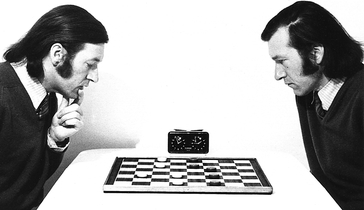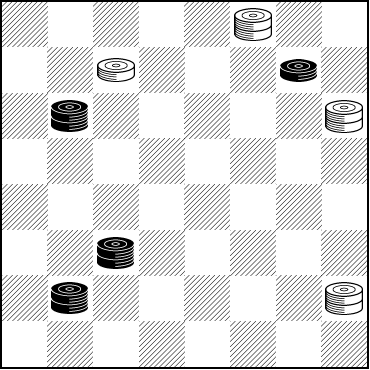The Checker Maven
Jump to navigationKen Lovell

Ken Lovell "Self Portrait" 1978
In today's column, we present English draughtsman Ken Lovell, a high level player who has done much to promote draughts (checkers) in the UK. Ken has offered our readers a unique book of his, Draughts Books of the 20th Century, an 86 page compilation, with commentary, of listings of a very large number of books published during the subject time period. Get your free copy here.
Ken was gracious enough to answer our interview questions.
You have had a long and very distinguished career in playing and promoting draughts. How did you get interested in draughts?
My first serious interest began when as a teenager I found a copy of Derek Oldbury's Move Over in a local library.
Are there any player(s) whom you consider to be a particular inspiration, or mentor?
My dad taught me how to play when I was very young and we had many enjoyable games.
What are a couple of moments in your career that are particularly memorable or noteworthy for you?
Although I've never won any national tournaments I did manage to win the English Amateur Championship in 1985 and the English Matchplay Championship in 2018.
Tell us a little about Ken Lovell the person, of which Ken Lovell the draughts player is a part.
I belong to the Black Country, a small area in England which was at the heart of the industrial revolution.
My working life consisted of a brief period at a grammar school as a chemistry teacher, followed by 26 years as a colour technologist in the plastics industry, from which I was able to take early retirement in 1996.
I'm single but have a lady friend.
Apart from varieties of draughts (Anglo-American, International 10x10 and Canadian) my interests include studying French and Latin, secularism, book-collecting, steam railways, photography, local history and Scrabble.
There are skeptics who think draughts is on an irreversible decline. What would you say to them and what do you see for the future of the Anglo-American style of draughts?
Sadly l would have to agree with them as far as Great Britain is concerned. We are managing to hold national tournaments with generous prizes, but the EDA (English Draughts Association) is struggling and the club scene is virtually dead. In contrast, our game is thriving in other parts of Europe and on other continents--- we can only hope that at some time in the future there will be a revival over here.
Anything else you'd like to add?
I was able to visit the USA in 1983 as a guest of Charles Walker at the International Checker Hall of Fame in PetaI, Mississippi. I was a spectator at the 4th US vs GB and Ireland International match, and was fortunate enough to meet Marion Tinsley and other top players.
I played in the British Open Championship in 1984, when there was an entry of 66, all playing in one section! Eventually the great Asa Long (reigning US Champion) made his way to the top of the pile and won the event. Although I didn't play him I was at his meal table every evening and had the great privilege of pouring his tea--- my claim to fame.
Ken is modest and a bit laconic, so we sought further commentary from the English Grandmaster Richard Pask. Below are Mr. Pask's reflections on Ken's career.
"He was introduced to the game by his father who, although not aware of the competitive game, was very keen on draughts. The first
tournament Ken attended, as a spectator, was the 1963 English Open Championship, which was held in Scarborough and won by Derek Oldbury. (Ken took the photograph of Derek, wearing dark glasses and smoking, which appeared in the Online Checkers Museum under the photos section. Speaking of which, Ken has always been keen on photography.)
"Ken has played at a solid, expert level for many years and taken part in many national tournaments, in addition to innumerable events in the West Midlands. Like me, Ken was very impressed with Derek Oldbury's excellent treatment of the Pioneer System given in his The Square World magazine and has managed to arrive at 'Diagram C' on hundreds of occasions in his draughts career. 'Boring' this position may be, as per Oldbury, but Ken has registered many wins, losses and draws from it!
"Without doubt, however, Ken is best known for his huge draughts library. It is without doubt the largest of its kind in the UK and Ireland, and surely ranks among the world's top 3 or 4."
We asked Ken for a favorite checker problem, and he did send along a very nice one. This problem appeared in ECB (Elam's Checker Board) Vol 21 No 1, Page 6970, Jan 1967.

WHITE
White to Play and Win
W:WK3,6,K12,K28:B8,K9,K22,K25
Our thanks to Ken for the book, the interview and the problem. You can click on Read More to see the solution.![]()
Solution
6-1* 8-11 3-7* 11-15 7-10* 15-19 1-5* 9-13 12-16* 19-23 5-9!* 13x15 16-19* 15x24 28x17 White Wins.
For historical purposes, here is the original version, which although marred by typos and an omitted move (8-11), contains interesting commentary including a description of the title, Snake Shot.

You can email the Webmaster with comments on this article.
